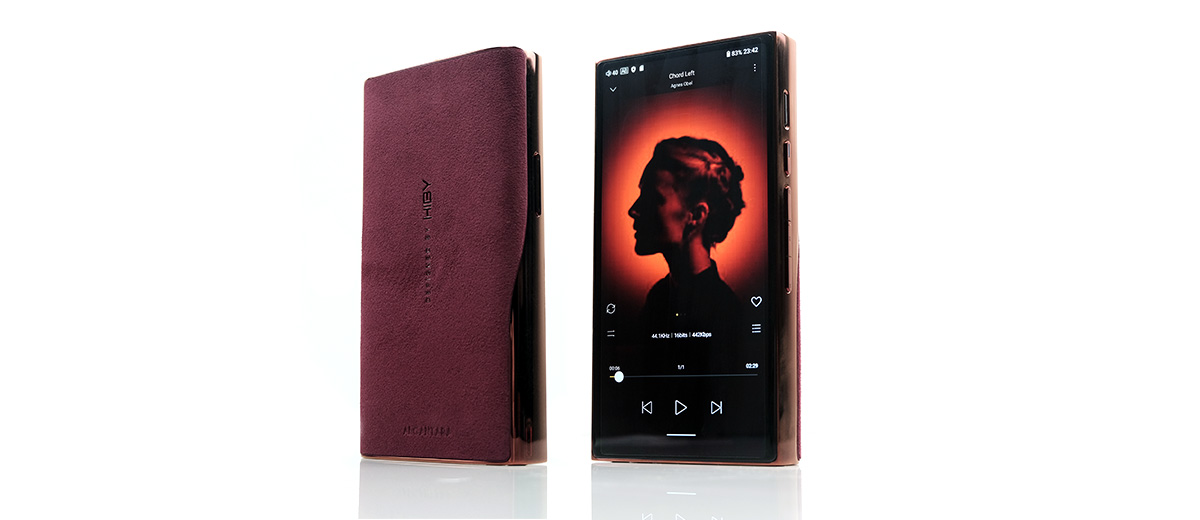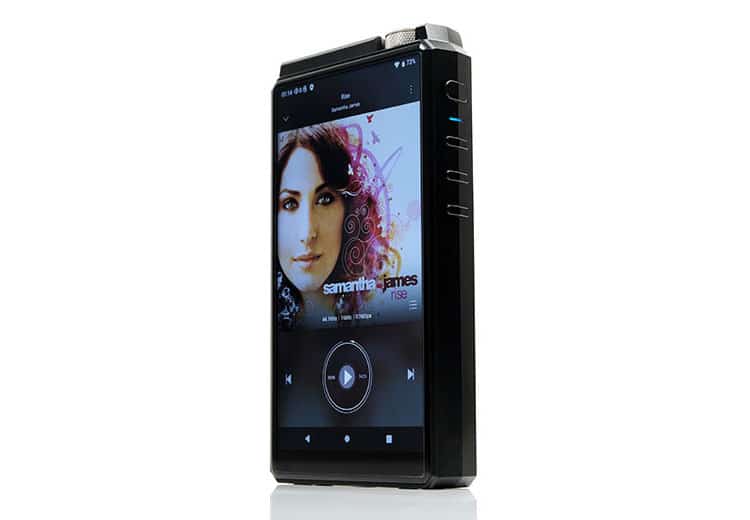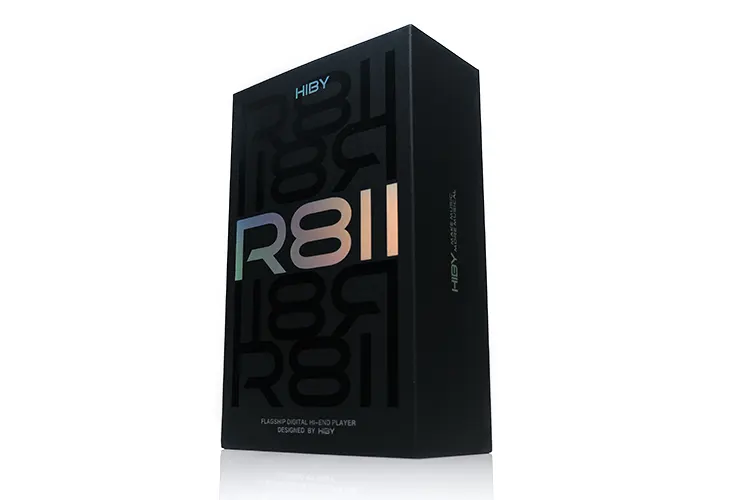Select Comparisons
The following comparisons to the R8 II were completed using a mix of the Unique Melody Multiverse Mentor, the JH Audio Jolene, and the FiR Audio Radon 6 from the 4.4mm balanced output using Turbo Mode and low gain.
HiBy R8
The HiBy R8 was launched in Q3 of 2020 and at the time was the company’s flagship model until the launch of the RS8. It also was our Top Gear 2020 Best DAP award winner.
Technical
Though both are delta-sigma-based for decoding, the R8 II represents an upgrade in almost every way.
We have DARWIN-MPA with an in-house delta-sigma 16X current mode conversion process capable of up to DSD1024 and PCM 32BIT/1536kHz as opposed to off-the-shelf dual AK4497EQ DACs and a lower DSD512 or 32bit/768kHz PCM decoding capability.
We also have Android 12 as opposed to Android 9, a Snapdragon 665 CPU over the older 660 version, and 8GB of RAM and 256 of ROM which is significantly more than the older R8’s 4GB of RAM and 64GB ROM.
I do take note though that at some point during the lifecycle of the R8 HiBy offered a second option upgraded to 6GB of RAM and 128GB of ROM.
The older R8 lacks dual-mode but is still the more powerful of the two DAPs at 1088mW balanced on a 32Ω load for PO compared to the R8 II at 710mW on the same weighting. HiBy has been heading in the ‘less is more’ direction with the R6 Pro II and the RS8 was under 1W also so this might be less of a surprise.
What has not changed seems to be the wireless performance with Bluetooth in particular which is still at BT5.0. Both DAPS offer LDAC and HiBy’s own UAT codec handling.
Some of the OS features not in the original R8 are there now in both the R8 II and the R8 including PEQ whilst system-wide Bitperfect playback is ever-present in both devices.
Design
Probably the most obvious change here is the form factor and design on the R8 II which is now a bit longer to make way for the improved 5.9″ 1080P Plus screen. The older R8 set the pattern for HiBy’s flagship DAPs over the last 2 generations with its squatter form factor and 5.5″ 1080P screen.
You also have that gorgeous Alcantara and color-themes stainless steel housing on the R8 II which is far more attractive than the R8’s plainer aluminum and glass panel finish.
The R8 also saw the introduction of the Alps potentiometer which is now gone on the R8 II. We now have a lower-profile volume rocker on the left pane which I am on the fence about as I like using a dial but recognize the design benefits of going without.
Physical controls on the new R8 II are sleeker but are they better? Depends on your usage preferences since that new thick TPU case with Alcantara sides is going to provide much better protection from dust than the older leather version but at the same time it makes it much harder to find the buttons.
Nothing has changed for PO and digital connectivity on the base panel with LO and PO options clearly separated. The switch from a tray-based memory card slot to an open version is something I prefer in daily use.
Lastly, I miss the older 1st gen R8 packaging and accessory line-up. It was quite stunning. The R8 II is more run-of-the-mill but still quite well done. I would also have liked to have seen the R8’s USB-C to coaxial conversion cable included with the R8 II packaging.
Performance
The best way to describe the performance comparisons between these two is the constant subconscious urge to drive up the volume of the R8 right after listening to the R8 II.
That urge has more to do with the dynamics of the R8 II and just how well it resolves within a much more complex stage on all three IEMs compared to the original R8.
The R8 is not as 3-dimensional in its presentation. It sounds softer in its attack and is comparatively muted in its dynamic range compared to the R8 II. It delivers a bass-first approach with a slightly warmer euphonic timbre, and gradually softens instrument and vocal presence the further up the FR you go with each tested IEM.
The R8 bass lacks the same punch, vibrancy, and definition that the R8 II equivalent can deliver. The R8 II’s better treble presence and extension on the tested IEMs helped create a more accurate tonal quality throughout.
The net result is a voluminous level of lows on the R8 with the paired IEM lows, but a relatively ponderous delivery and 2-dimensional in its positioning. I hate to say but it sounds like it has the life sucked out of it compared to the R8 II’s more boisterous lows.
The imaging and separation from the R8 II pairings are also miles ahead. The improved staging width, and more immediate cleaner vocal presence, particularly with the Multiverse Mentor, was palatable.
Every IEM I tested just sounded so much tighter, more vibrant, and resolving on the R8 II. The only case I could make for the R8 is if you have a particularly bright IEM and want a smoother non-offensive DAP pairing. Even then, MSEB and PEQ on the R8 II should resolve that.
HiBy RS8
The HiBy RS8 was launched in late 2022 and still is HiBy’s flagship DAP at the time of writing. It was also our Top Gear 2022 Best DAP award winner.
Technical
In some ways, the RS8 is the foundation upon which the R8 II is built. Both offer Android 12 with a Snapdragon 665 CPU as well as 8GB of RAM and 256GB of ROM.
They also both use a discrete DARWIN Architecture for their digital audio management with dual-mode balanced and single-ended PO and line-out amplification options.
However, the key differentiator here is the conversion. The RS8 uses DARWIN II R-2R whereas the R8 II uses an in-house 16-way current mode delta-sigma decoder. You will have fans of both no doubt about that and there are some qualitative performance differences which you can read more about in the performance section further down.
There are some technical differences between DARWIN II and DARWIN-MPA though. The tap filter has gone up from 256 to a much larger 1024 and the RS8 16fs oversampling rate has been increased to 128fs on the R8 II.
Decoding is the same on both at PCM 32BIT/PCM1536 and DSD1024 with 16X MQA unfolding capability as well as wireless 2.4gHz/5gHz and BT5.0 at up to LDAC 24Bit/96kHz as well as HiBy’s UAT.
The RS8 has an edge in amplification but only just at 780mW balanced and 280mW unbalanced on a 32Ω load compared to 710mW and 225mW on the R8 II and both have Turbo mode capability which I tend to leave on for both DAPs regardless of gain level. Line-out is the same for both DAPs at 4Vrms balanced and 2Vrms unbalanced.
Design
The RS8 form factor and design language are more R8 than R8 II with one significant difference, the weight. Coming in at 584g which is 69g heavier than the R8 II due to the use of titanium as opposed to aluminum or stainless steel for its housing.
Dimensionally, it is smaller than the R8 II and uses the older 5.5″ 1080P screen that was first seen inside the R8. I have to say the new 1080P plus screen not only offers more screen real estate but the color palette and better pixel density are also more pleasing to my eye.
The aesthetics of the R8 II are more graceful and innovative with the blend of Alcantara and reflective stainless steel housing but it is going to be more high maintenance than the titanium on the RS8. There will also be some who prefer the leather case of the RS8 over the TPU version that comes with the R8 II.
Physical controls are similar to the R8 with the use of the Alps potentiometer as opposed to a volume rocker and the bunched-up buttons on the top right-hand side of the panel. Aesthetically, the R8 II layout is nicer looking but not necessarily an advantage for ease of use once the TPU case goes on.
The base panel on both DAPs is almost the same. There is no difference in the LO/PO and USB-C arrangement but the R8 II lacks the RS8 gold-plated connectors on its 3.5mm jacks. Both offer open slots for external memory cards, which I prefer over pin trays.
Performance
The secret sauce of the RS8 is in the timbre and the lows, the R8 II’s equivalent is in the clarity of the mids and vocal presence. The gap between these two widens or narrows depending on the pairing and this is where timbre also plays a role.
In terms of dynamic range and resolution, I honestly could not pick much of a difference between them. Neither of these players lacked in terms of micro-detail but again, going back to the tonal emphasis and what each DAP teased out of the three IEMs is a big factor in preference.
The R8 II is comparatively more neutral and cleaner whereas the RS8 is a firmer more analog-sounding coloration. That should not be a surprise given their respective DS and R-2R backgrounds.
The RS8 also offered more sub-bass presence and bass body compared to the R8 II, though I found the latter to be perceptibly punchier and cleaner in the same region.
The mids offered that same analog overtone from the RS8 but with a more neutral imaging quality for vocals. The R8 II sounded more vibrant and open through the mids with vocal presence benefitting and sounding further forward.
I think a lot of that also has to do with the R8 II highs which have a bit more upper-treble presence though both extend supremely well. That gives the R8 II a slightly higher level of contrast on midrange notes hence the vibrancy but slightly less body.
The fuller-sounding and more analog RS8 traits are more suitable for the FiR Audio Radon 6 pairing which sounds comparatively leaner on the R8 II. I gravitated towards the Multiverse Mentor for the R8 II simply because of how well it captured the IEM’s pinpoint mids imaging.
Cayin N7
The Cayin N7 was released in 2023 with our review coming out not long after its launch. Its price point is the exact same as the R8 II and also offers some innovative decoding technology.
Technical
Both of these DAPs are discrete engineered but in a nutshell, this is in-house delta-sigma with DARWIN-MPA Architecture versus a discrete differential 1-BIT DAC.
The N7 is the first DAP to use a 1-BIT DAC for processing DSD, which is a 1-BIT audio file format, as opposed to PCM, which is multibit. PCM itself is converted to 1-BIT bitstream before it is sent to the DAC. The DAC itself is a resistor network DAC but not an R-2R solution used by something like the RS8.
The contention here is that DSD, decoded in its unaltered 1-BIT format, will sound significantly superior to DSD audio that has to go through an SRC multibit converter.
The R8 II has a higher decoding ability at DSD1024 and PCM 1536kHz as opposed to the N7’s PCM 32BIT/768kHz and native DSD512. Commercially not many places offer DSD1024 but Native DSD is one such website that does.
Both devices are bitperfect and offer MQA 16X with BT5.0 wireless capability up to LDAC 24BIt/96kHz and UAT compatibility.
Each DAP offers a dual-mode Class A and Class AB amplification option though the R8 II technically has the more powerful output level at 710mW balanced as opposed to 500mW from the N7 into a 32Ω load.
The N7 does not offer any voltage enhancements such as P+ or the R8 II’s Turbo Mode. However, it does have a trick up its sleeve with a pre-out option and this is where the N7 pulls ahead with its dedicated DAC output capability.
On the software level things are very similar with both DAPs using an open Android 12 powered by a Snapdragon 665 CPU. However, the N7’s 4 GB of RAM and 64 GB of onboard ROM are way below the R8 II’s 8 GB and 256 GB numbers.
Design
The R8 II has the more appealing aesthetic but the N7 has a more pocketable form factor. The N7 is far smaller and lighter at 380g compared to 515g and much easier to use single-handed though it does become a shade thicker once you put on the stock leather case.
The presentation of the R8 II with the stainless steel and Alcantara mix combined with the larger 5.9″ 1080P plus screen will catch more people’s attention. It is pure eye-candy though diminished a little when the TPU case goes on. Compared to the more traditional aluminum alloy case on the N7 the R8 II Alcantara wrap is also higher maintenance.
The N7 keeps a volume dial on the top panel similar to the N8ii and RS8 which HiBy did away with on the R8 II. I find the Cayin implementation of the dial to be very good though, quite responsive and accurate.
Once you get that articulation and balancing just right for a dial pot then the arguments for the R8 II digital rocker become more challenging. At least in my personal experience of using both it just feels more intuitive to use a dial, especially when the R8 II case goes on and the Alcantara wrap makes the rocker harder to find.
The N7 has its case weakness also with the bottom PO and LO labeling being hidden by the frame of the case. If you need to double-check where to insert your jack you need to slide the case down again to check unless you have them memorized.
I also find the inclusion of a mini I²S socket on the base of the N7 very beneficial for connectivity to I²S compatible DACs and keeping the USB port free for charging during use.
Performance
These two DAPs have very different interpretations of emphasis and coloration within their respective amplifier modes.
Class A on the N7 does not follow the same logical changeups when moving from Class AB when compared to the R8 II. The lows on the N7 become more emphasized with a denser full sound giving the mode and much weightier sound compared to its Class AB.
The R8 II’s Class AB has the more dynamic set of lows and for weight has the edge over its smoother but more evenly balanced Class A tuning.
The N7 Class A mode is the outlier for me because it’s been traditional for Class A to be the smoother more relaxed operational mode. In this case, it is HiBy who has followed ‘tradition’ and Cayin who has pushed the envelope.
Comparing like for like, the R8 II is fuller-sounding in Class AB and vice versa with the Cayin N7 in Class A. Through the mids, the N7 is the more analog and natural-sounding performer.
The R8 II has the delta-sigma sound with a shorter decay, a more polished ‘perfect tone’, in part drawing from its stronger upper treble presence which gives upper order harmonics more influence.
Staging performance is an interesting contrast also. I think at a high level the R8 II has a bit more about it in terms of height and treble articulation. It will seem the more resolving and on balance that might well be the case. Certainly, it is more lively and can deliver a faster ‘shift’ with micro-detail more to the fore.
However, in terms of placement, the N7 staging comes across as more natural with a bit more vocal forwardness and better separation from the background instrumental imaging.
Our Verdict
I am both surprised and impressed with the performance of the HiBy R8 II DAP. With its lower price point than the flagship RS8, I was expecting something slightly scaled down but in fact, I think we might have gotten something even more ambitious.
The quality of the performance is exciting, engaging, and highly resolving. It has a lot more drive and energy with tested pairings compared to the original R8 and a vocal presence and midrange openness that might tick more boxes than the RS8’s equivalent.
It also looks great with a much-improved screen. The new Alcantara wrap might not be for everyone but at least in red it looks innovative and very different to what’s out there. My only real gripe is the case which makes finding the volume rocker tricky as well as blocking some 4.4mm plugs from connecting properly.
With all that going on you can easily take for granted that like its predecessors it’s built on a solid software platform with an excellent engine and plenty of RAM to keep it moving nice and quick for modern user needs.
It is only January in the Awards race but I have to say the HiBy R8 II is already in the mix as a potential contender.
HiBy R8 II Technical Specifications
- Operating System: Android 12
- CPU: Snapdragon 665
- DAC: Darwin-MPA architecture
- Opamps: OPA1612*3, ADA4625-2*2
- Output power: 710mW (32ohms) (Balanced), 225mW (32ohms) (Single-ended)
- Line-out: 4Vrms (Balanced, 2Vrms (Single-ended)
- WiFi: Supports 2.4 and 5GHz
- Bluetooth: Bluetooth 5.0
- USB: USB 3.1
- Screen: Size: 5.9”, Screen Type: IPS, Resolution: 1080*2160
- RAM: 8GB
- Onboard Storage: 256GB, Micro SD Supports up to 2TB
- Body Material: Stainless Steel
- Dimensions: 149*78*23 mm, Weight: 515g
- Power Supply: 12V⎓1.8A or 5V⎓0.5A
- Battery Capacity: 12000mAh/3.8V
- Charging time: 5 hours
- Misc Firmware Updates: Supports OTA updates over WiFi | Third-Party Apps: Unlimited installation and use






